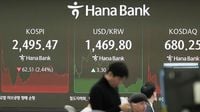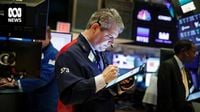Asian shares experienced a significant downturn on Monday, March 31, 2025, as investors reacted to a troubling combination of economic factors, including rising inflation and a slowing U.S. economy. The Tokyo Stock Exchange's Nikkei 225 index dropped more than 4%, closing down 4.1% at 35,615.15. Other major Asian markets followed suit, with Hong Kong's Hang Seng index losing 1% to 23,200.65 and the Shanghai Composite index declining by 0.5% to 3,333.66. South Korea's Kospi fell 2.6% to 2,492.49, while Australia's S&P/ASX 200 sank 1.6% to 7,856.80. Taiwan's Taiex lost 3.4%, reflecting widespread concern across the region.
The sell-off in Asia was largely influenced by a sharp decline on Wall Street the previous Friday, where the S&P 500 fell 2% to 5,580.94, marking one of its worst trading days in two years. The Dow Jones Industrial Average plummeted 715 points, or 1.7%, to 41,583.90, while the Nasdaq composite dropped 2.7% to 17,322.99. Market analysts attributed these losses to fears surrounding potential stagflation—an economic condition characterized by stagnant growth and high inflation.
Concerns about the U.S. economy have been heightened by President Donald Trump's escalating tariffs, which many fear could lead to reduced consumer spending. A recent survey by the University of Michigan revealed that two out of three U.S. consumers expect unemployment to worsen over the next year, the highest level of pessimism since 2009. This sentiment raises alarms regarding the job market, which has been a crucial pillar supporting the U.S. economy.
The market's reaction was evident in specific sectors, particularly those reliant on consumer confidence. Lululemon Athletica led the market decline with a staggering 14.2% drop on Friday, despite reporting stronger-than-expected quarterly profits. Similarly, Oxford Industries, known for its Tommy Bahama and Lilly Pulitzer brands, saw its stock fall 5.7%, even after posting better-than-anticipated results.
Other companies that felt the pinch included Delta Air Lines, which lost 5%, and Caesars Entertainment, also down 5%. The technology sector was not spared, with heavyweights like Apple and Microsoft contributing to the overall market decline due to their significant influence on major indexes.
As the global markets brace for more volatility, investors are also keeping a close eye on commodity prices. U.S. benchmark crude oil fell 40 cents to $68.96 per barrel, while Brent crude dropped 36 cents to $72.40. The U.S. dollar weakened against the Japanese yen, trading at 148.86 yen, down from 149.84 yen, while the euro rose to $1.0838 from $1.0803.
In Australia, the S&P/ASX 200 experienced a notable decline, shedding approximately $45 billion in value, or 1.7%, as the market closed. The ASX 300 metals and mining index was particularly hard hit, down 3.6%. Major players in the mining sector, including BHP, Rio Tinto, and Fortescue, saw their stocks drop between 3.8% and 4.8%. This sell-off was fueled by fears of a global economic slowdown and rising inflation, exacerbated by the anticipated tariffs from the Trump administration.
Amidst the turmoil, gold emerged as a safe haven, reaching a new record high of over $3,100 per ounce, reflecting increased investor interest in precious metals during uncertain economic times. The rise in gold prices stands in stark contrast to the overall market sentiment, indicating a flight to safety among investors.
As the ASX closed, 184 of the top 200 companies reported losses, underscoring the widespread impact of the market downturn. The banks also faced challenges, with ANZ down 1.9% and Macquarie shedding 3.4%, although Commonwealth Bank managed a slight gain of 0.3%. Packaging company Orora was one of the few bright spots, gaining 4.4% after clarifying its position following a raid by French competition authorities.
The market's instability is expected to continue as the April 2 deadline approaches for the implementation of additional tariffs, dubbed "Liberation Day" by President Trump. This uncertainty is likely to weigh heavily on consumer and business confidence, as stakeholders await the full impact of the tariffs on the U.S. economy.
In summary, the combination of rising inflation, consumer pessimism, and geopolitical tensions has created a challenging environment for global markets. Investors are urged to remain vigilant as economic indicators continue to evolve, and the potential for stagflation looms large.





